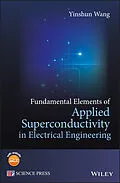Superconducting technology is potentially important as one of
the future smart grid technologies. It is a combination of
superconductor materials, electrical engineering, cryogenic
insulation, cryogenics and cryostats. There has been no specific
book fully describing this branch of science and technology in
electrical engineering. However, this book includes these areas,
and is essential for those majoring in applied superconductivity in
electrical engineering.
Recently, superconducting technology has made great progress.
Many universities and companies are involved in applied
superconductivity with the support of government. Over the next
five years, departments of electrical engineering in universities
and companies will become more involved in this area. This
book:
* will enable people to directly carry out research on
applied superconductivity in electrical engineering
* is more comprehensive and practical when compared to other
advances
* presents a clear introduction to the application of
superconductor in electrical engineering and related fundamental
technologies
* arms readers with the technological aspects of
superconductivity required to produce a machine
* covers power supplying technologies in superconducting
electric apparatus
* is well organized and adaptable for students, lecturers,
researchers and engineers
* lecture slides suitable for lecturers available on the
Wiley Companion Website
Fundamental Elements of Applied Superconductivity in Electrical
Engineering is ideal for academic researchers, graduates and
undergraduate students in electrical engineering. It is also an
excellent reference work for superconducting device researchers and
engineers.
Autorentext
Yinshun Wang, North China Electric Power University, China
Zusammenfassung
Superconducting technology is potentially important as one of the future smart grid technologies. It is a combination of superconductor materials, electrical engineering, cryogenic insulation, cryogenics and cryostats. There has been no specific book fully describing this branch of science and technology in electrical engineering. However, this book includes these areas, and is essential for those majoring in applied superconductivity in electrical engineering.
Recently, superconducting technology has made great progress. Many universities and companies are involved in applied superconductivity with the support of government. Over the next five years, departments of electrical engineering in universities and companies will become more involved in this area. This book:
• will enable people to directly carry out research on applied superconductivity in electrical engineering
• is more comprehensive and practical when compared to other advances
• presents a clear introduction to the application of superconductor in electrical engineering and related fundamental technologies
• arms readers with the technological aspects of superconductivity required to produce a machine
• covers power supplying technologies in superconducting electric apparatus
• is well organized and adaptable for students, lecturers, researchers and engineers
• lecture slides suitable for lecturers available on the Wiley Companion Website
Fundamental Elements of Applied Superconductivity in Electrical Engineering is ideal for academic researchers, graduates and undergraduate students in electrical engineering. It is also an excellent reference work for superconducting device researchers and engineers.
Inhalt
Preface xiii
Acknowledgments xv
Abbreviations and Symbols xvii
1 Introduction 1
References 3
2 Superconductivity 5
2.1 The Basic Properties of Superconductors 5
2.1.1 Zero-Resistance Characteristic 5
2.1.2 Complete Diamagnetism Meissner Effect 11
2.1.3 Josephson Effects 15
2.2 Critical Parameters 17
2.2.1 Critical Temperature Tc 18
2.2.2 Critical Field Hc 18
2.2.3 Critical Current Density Jc 18
2.3 Classification and Magnetization 19
2.3.1 Coherence Length 19
2.3.2 Classifications 21
2.3.3 Type I Superconductor and Magnetization 22
2.3.4 Type II Superconductor and Magnetization 22
2.4 Measurement Technologies of Critical Parameters 27
2.4.1 Cryogenic Thermometers 27
2.4.2 Measurement of Critical Temperature 27
2.4.3 Measurement of Critical Current Ic 33
2.4.4 Measurement of Critical Magnetic Field 40
References 43
3 Mechanical Properties and Anisotropy of Superconducting Materials 45
3.1 Mechanical Properties 45
3.1.1 General Description of Mechanical Properties 45
3.1.2 Tensile Properties 46
3.1.3 Bending Properties 47
3.2 Electromagnetic Anisotropy 48
3.2.1 Anisotropy of Critical Current in HTS Materials 49
3.2.2 Anisotropy of Critical Current in 1G HTS Tape 50
3.2.3 Anisotropy of Critical Current in 2G HTS Tape 53
3.2.4 Anisotropy of Critical Current in Bi-2212 Wire 55
3.2.5 Anisotropy of n Value for HTS Tape 55
3.2.6 Anisotropy of Critical Current Density in HTS Bulk 56
3.3 Critical Current Characteristics of LTS Materials 57
3.3.1 Dependence of Critical Current Density of NbTi on Magnetic Field 58
3.3.2 Dependence of Critical Current Density of NbTi on Magnetic Field and Temperature 58
3.3.3 Dependence of Critical Current Density of Nb3Sn on Magnetic Field 59
3.4 Irreversible Fields of Superconducting Materials 60
3.5 Critical Temperature of Several Kinds of HTS Materials 61
3.6 Thermodynamic Properties of Practical Superconducting Materials 62
3.6.1 Thermal and Mechanical Characteristics of Practical
Superconducting Materials 62
3.6.2 Thermal Contraction of Superconducting Materials 65
References 67
4 Stability of Superconductors 71
4.1 Critical States 72
4.2 Adiabatic Stabilization 72
4.3 Adiabatic Stability with Flux Jump 75
4.4 Self-Field Stability 79
4.5 Dynamic Stability 82
4.5.1 Stability of Composite Superconducting Slab with Cooled Side 83
4.5.2 Stability of Composite Superconducting Slab with Cooled Edge 87
4.5.3 Dynamic Stability of Current-Carrying Composite Superconductor Slab 89
4.5.4 Dynamic Stability of Current-Carrying Composite Superconductor with Circular Cross-Section 91
4.6 Cryostability 95
4.6.1 Stekly Parameter 96
4.6.2 OneDimensional Normal Zone Propagation 100
4.6.3 Three-Dimensional Normal Propagation Zone and Minimum Quench Energy 101
4.7 NPZ Velocity in Adiabatic Composite Superconductors 105
4.7.1 Longitudinal Propagation Velocity 105
4.7.2 Transverse Propagation Velocity 107
4.8 Stability of HTS Bulks 109
4.8.1 Evolution of Super-Current Density 109
4.8.2 Magnetic Relaxation 110
4.9 Mechanical Stability of Superconducting Magnets 112
4.10 Degradation and Training Effect of Superconducting Magnets 113
4.10.1 Degradation of Superconducting Magnets 113
4.10.2 Training Effects of Superconducting Magnets 114
4.11 Quench and Protection of Superconducting Magnets 114
4.11.1 Resistance Increase and Current Decay in Quench Processes 115
4.11.2 Factors Causing Quench 122
4.11.3 Active Protection 124
